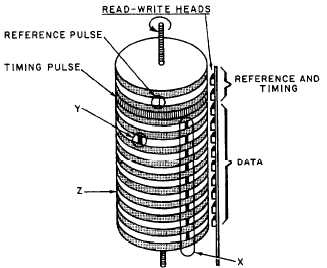static or dynamic.
MOS means metal oxide
semiconductor, and LSI means large scale integration.
Thin Film
Thin film memory consists of Permalloy, a
ferromagnetic material, deposited on a supporting
material (substrate) of thin glass. This is done under
controlled conditions in a vacuum chamber. When all
air has been removed from the chamber, a shutter
arrangement is opened, and vapors from molten
Permalloy pass through a mask and are deposited on
the supporting material. The pattern thus formed is
determined by the shape of the mask. The thickness
of each spot (magnetized area) is controlled by the
amount of time the shutter is open.
A magnetic field is applied parallel to the surface
of the substrate during deposition. The film spots
become easier to magnetize in the direction parallel to
that in which the magnetic field was applied during
the deposition process. This direction is known as the
preferred direction; likewise, the axis of this
magnetism is called the preferred axis.
Magnetic Drums
The magnetic drum storage device is a cylinder
that rotates at a constant velocity. Information is
written on or read from the drum when its magnetic
surface passes under magnetic heads, which are
similar to the magnetic heads found on commercial
tape recorders.
Magnetic drums provide a relatively inexpensive
method of storing large amounts of data. A magnetic
drum (fig. 8-3) is made from either a hollow cylinder
(thus the name drum) or a solid cylinder. The cylinder
may consist entirely of a magnetic alloy, or it may
have such an alloy plated upon its surface. Many
drums are made by spraying on magnetite, an iron
oxide. The surface is then coated with a thin coat of
lacquer, and buffed.
Representative drums have diameters ranging
from 12.7 to 50.8 centimeters (about 5 to 20 inches
respectively). The surface of the drum is divided into
tracks or channels that encircle the drum. A number
of READ and WRITE heads are used for recording
and reading. There is at least one head per track. The
drum is rotated so that the heads are near, but not
touching, the drum surface at all times.
As the drum rotates, the tracks are continuously
passing under their respective head. Each track is
subdivided into cells, each of which can store one
binary bit. All the cells that are positioned under the
heads of a multitrack drum at the same time are called
a “slot.” With some drums, each head reads or writes
one bit of a word. Thus, when a word is written into
or read from a slot, each track contains one bit of that
word. The number of heads used depends on the size
of the word that the computer is designed to handle.
One of the tracks provides timing signals for the
drum rotation.
The timing track determines the
location of each set of storage cells around the drum.
Each timing signal denotes a unit of time of drum
rotation. For example, if the timing track is 80 inches
long and timing signals are recorded at 120 pulses per
inch, there are 9,600 locations for bit storage on the
track. If the drum has 32 tracks in addition to the
timing track, the drum has the capacity to store a total
of 307,200 bits.
Some drums use two or even three timing tracks.
The timing tracks are used for synchronization
purposes and are sometimes called “control” or
“clock” tracks. The timing pulses establish the time
scale to which all circuits through the computer are
synchronized.
The retrieval of data from a rotating drum can be
a rather involved process, as can be realized by
drawing a comparison to the core memory of a
computer. When core memory is used, all the data is
stored in the cores in a static condition. The data can
be located at a given place at any instant, and can be
easily read from that location in serial or parallel form
Figure 8-3.-Magnetic drum.
8-7


